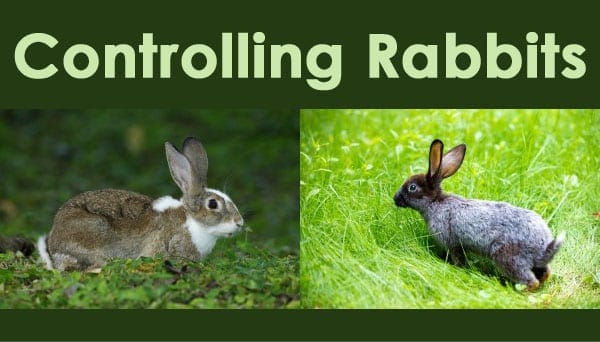Newsletter Articles
Controlling Rabbits
By Richard Flowers, ACCNP-Green Thumb Nursery-Ventura
They have fluffy fur, short tails, long ears, and whiskers. These small mammals are known as rabbits and are mostly herbivores; eating leafy greens, seeds, grasses, flower buds, and fruits.They have adapted to living in suburban areas and surrounding sites where plenty of food is available at their disposal. In the wild, they prefer to eat the natural growing vegetation but until more recent times, human population have grown exponentially and development has occurred. The result, bunnies adapted to live in this environment. Irrigated and fertilized landscapes, delicious flowers, and yummy plants are all within reach while at the same time the homeowner is becoming frustrated with damaged plants in their beloved gardens. Today, both people and rabbits need to find a happy medium of which to live together.
One family of rabbits in your area may mow down a certain plant in your yard but a different group will avoid the same plant in your neighbor’s yard down the street. When rabbits are hungry enough, they’ll eat just about anything! Just like people, they prefer certain foods over others. By growing plants they dislike or placing such plants next to the ones they do like, you may discourage feeding. There is no guarantee that any of the plants listed as resistant will remain free from damage in all conditions.
Salvias:
Salvias are a large group of plants, some are used for culinary purposes while others are just for ornamental appearance. They attract hummingbirds with their tubular shaped flowers in various colors. Many salvias or sages have aromatic foliage that might deter rabbit feeding. Some are native to California.
Daylily:
Daylilies bloom in a rainbow of shades and can take all but the toughest conditions. Grow them in full sun and enjoy their easy-growing beauty. If the tops are eaten up by rabbits don’t worry they will come back from the fibrous roots. The same philosophy may also be also applied to other such plants like Agapanthus, Lilly Turf, Society Garlic, and other plants that grow from underground roots.
Lavender:
Lavender is another large group of plants that produces wonderfully fragrant foliage and flowers. The blooms typically appear in shades of violet and are wonderful for drying and using in sachets and other craft projects. Like the Salvia, of which it is related to, the scent may also discourage rabbit feeding.
Herbs:
you may also want to consider using Basil, Rosemary, Mint, Parsley, Oregano, and Tarragon in your gardens because they are also less likely to be devoured by rabbits.
Yarrow:
Lovely Yarrow is not just rabbit resistant, it’s also a hardy, drought-tolerant perennial. This rugged plant blooms through the summer in shades of yellow, pink, red, and white. The long-lasting blooms are beautiful in a vase and in the garden.
Gardeners in rabbit-infested areas may get some additional ideas by seeing what other plants survive in neighboring gardens. Species that are older, woody, and bigger are less desirable or more able to come back after being attacked. Once a plant develops rough bark, rabbits tend to leave them alone except for young shoots. Be aware that rabbits may eat anything during times of drought. Most plants are also more desirable when they are over-watered or over-fertilized because the new tender growth is favorable to them. New plants fresh from the nursery are very tender and tasty, so they may need some temporary protection for 4 to 6 months until they toughen up.
Here are popular methods for curtailing rabbit activity:
For young plants, I recommend using chicken wire with 1 inch or smaller mesh and make a fence that stands 18-24” high that totally surrounds your treasured speimens. Make sure to bury the fence underneath the soil about 18 inches so the rabbits do not burrow underneath to have access to your plants. Secure the fencing to stakes pounded in the ground every couple feet so the barrier will not fall over. Be sure to inspect fencing frequently to make sure rabbits haven’t created an opening. Some people have even used bird netting instead of chicken wire.
Habitat Removal:
Many people overlook this simple strategy for keeping rabbits out of the garden. Remove places they tend to hide like brush piles, tall grass, low-growing shrubs, and rock piles . Rabbits also love to slip beneath sheds, porches, and low decks. Block openings to prevent access.
Scare Tactics:
The best way to scare a rabbit is to give your dog or cat free run of the yard. Other items, such as aluminum pie pans, fake owls, flashing lights, or ultrasonic devices, may work for a short time.
Repellents:
Rabbit repellents work either by releasing a repulsive odor or by making plants taste bad. Taste-based repellents are usually more effective, although it varies depending on other available foods and how many animals are present. Many repellents need to be reapplied after it rains or watering. Also, use caution when applying repellents to edible crops, as some make your harvest inedible to people.
I hope you find this article useful and happy gardening. I’ll see you at the nursery.
Do you like what you see? Sign up for our weekly newsletter to get content like this every week!
CLICK HERE TO SIGN UP!

